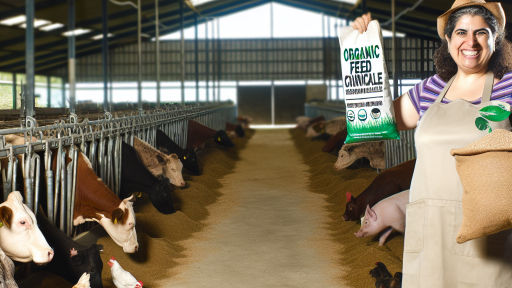Understanding CSA (Community Supported Agriculture)
Definition of CSA
Community Supported Agriculture, or CSA, connects farmers directly with consumers.
In this model, community members buy shares of the harvest in advance.
Essentially, this pre-purchase supports farmers even before their crops are ready.
Members receive their share of produce regularly during the growing season.
This creates a direct relationship between the grower and the consumer.
Importance of CSA
CSA plays a crucial role in modern agriculture.
It provides farmers with financial stability early in the season.
This approach reduces marketing costs and time for farmers.
Additionally, it encourages local food consumption.
Community members gain access to fresh, seasonal produce.
This fosters a sense of community and connection to the land.
Benefits for Farmers
Farmers enjoy numerous advantages through CSA participation.
Firstly, it helps improve cash flow by securing funds in advance.
This financial security empowers farmers to plan better for the season.
Additionally, it reduces the risks associated with crop failures.
Transform Your Agribusiness
Unlock your farm's potential with expert advice tailored to your needs. Get actionable steps that drive real results.
Get StartedFurthermore, farmers can cultivate a loyal customer base.
This engagement leads to better support for local agriculture.
Benefits for Consumers
Consumers also experience multiple benefits from CSA programs.
They enjoy fresh, organically grown produce directly from local farms.
This often includes unique varieties not found in supermarkets.
Moreover, consumers can engage with farmers and learn about their practices.
This transparency fosters trust and community involvement.
Ultimately, consumers eat healthier while supporting local economies.
Benefits of CSA Farming for Modern Farmers and Communities
Strengthening Local Economy
Community Supported Agriculture (CSA) directly benefits local communities.
It encourages consumers to buy directly from farmers.
This practice keeps money circulating within the community.
Farmers typically receive payments upfront from subscribers.
Consequently, this financial support aids in farm sustainability.
Enhancing Food Security
CSAs contribute to improved food security in communities.
They provide fresh produce directly to families.
Access to local food decreases reliance on imported products.
This access also promotes healthier eating habits.
Overall, it fosters a connection between people and their food sources.
Building Stronger Community Connections
Participating in a CSA cultivates community relationships.
Members often engage in farm activities and events.
This involvement fosters a sense of belonging and support.
Additionally, it creates opportunities for educational workshops.
Farmers can share knowledge about sustainable practices and nutrition.
Promoting Sustainable Practices
CSAs emphasize organic and sustainable farming methods.
Showcase Your Farming Business
Publish your professional farming services profile on our blog for a one-time fee of $200 and reach a dedicated audience of farmers and agribusiness owners.
Publish Your ProfileFarmers often focus on crop diversity and soil health.
This commitment helps reduce environmental impacts.
Furthermore, it enhances biodiversity in local ecosystems.
As a result, customers enjoy high-quality, chemical-free produce.
Fostering Innovation and Adaptability
CSAs encourage farmers to innovate and adapt.
They gain valuable feedback directly from consumers.
This information helps farmers adjust their offerings.
Moreover, they can experiment with new crops and practices.
This adaptability is essential in an ever-changing climate.
Key Best Practices for Building Strong CSA Memberships
Engaging the Community
Engagement starts with understanding your community’s needs.
Organize local events to foster relationships with potential members.
Consider hosting farm tours to showcase your operations.
Additionally, offer seasonal events to build interest throughout the year.
Clear Communication
Transparent communication is essential for building trust.
Keep members updated about farm progress and challenges.
Utilize newsletters, social media, and direct emails for effective outreach.
Moreover, personalize communications to make members feel valued.
Quality Produce
Delivering high-quality produce is critical for retention.
Focus on growing organic and seasonal items that appeal to your audience.
Implement quality control measures to ensure consistent offerings.
Feedback from members can enhance product selection and satisfaction.
Flexible Membership Options
Offer flexible membership options to accommodate different lifestyles.
Consider providing various sizes of share packages.
Introduce flexible pick-up options for added convenience.
Additionally, exploring a payment plan can make memberships more accessible.
Building a Strong Online Presence
A strong online presence attracts new members effectively.
Create a user-friendly website with essential information about your CSA.
Engage with members through social media channels to foster community.
Use online platforms to facilitate purchases and subscriptions easily.
Participatory Opportunities
Involve members in farm activities for deeper connection.
Host volunteering days to engage members in farm work.
Organize workshops that educate members about sustainable practices.
Furthermore, participants often become passionate advocates for your farm.
Explore Further: Sustainable Farming Equipment And Innovations
Seasonal Planning: What to Grow and When for CSA Success
Understanding Seasonal Variations
Each season presents unique opportunities for growing various crops.
Farmers must adapt their practices to seasonal variations effectively.
For instance, spring is ideal for planting cool-season crops.
Summer offers a chance to grow heat-loving vegetables.
By understanding these variations, farmers can maximize their yields.
Selecting Crops for Each Season
Choosing the right crops is vital for CSA success.
Showcase Your Farming Business
Publish your professional farming services profile on our blog for a one-time fee of $200 and reach a dedicated audience of farmers and agribusiness owners.
Publish Your ProfileCool-season crops include lettuce, spinach, and radishes.
On the other hand, tomatoes, peppers, and squash thrive in warm weather.
Farmers should also consider fall crops like kale and root vegetables.
Effective crop selection leads to diverse and attractive CSA offerings.
Timing Your Planting Schedule
Proper timing is crucial for successful crop growth.
Utilize local hardiness zones to determine planting times.
Starting seeds indoors can give early crops a jumpstart.
Transplant seedlings when the soil is warm enough and frost is unlikely.
Maintaining a detailed planting calendar helps manage these tasks.
Crop Rotation and Soil Health
Implementing crop rotation enhances soil fertility.
Rotate crops to prevent pests and diseases from taking hold.
Crops like legumes enrich the soil with nitrogen.
This practice maintains soil health and improves overall yields.
Communicating with Your CSA Members
Keep CSA members informed about what to expect each season.
Provide newsletters or updates on crop availability and planting plans.
Engaging members creates a sense of community and trust.
This communication reinforces member commitment to the CSA.
Gain More Insights: Promoting Local Agriculture via School Programs
Effective Communication Strategies with CSA Members
Building Strong Relationships
Effective communication starts with strong relationships.
Farmers should regularly engage with members to foster trust.
Utilizing personalized greetings can make members feel valued.
Additionally, remembering names and preferences enhances connection.
Utilizing Digital Tools
Digital platforms can streamline communication with CSA members.
Email newsletters keep members updated on farm news.
Social media can be used to share farming milestones and products.
Moreover, creating a dedicated website offers essential information easily.
Consider incorporating online surveys to gather feedback from members.
Transparency in Operations
Transparency builds trust between farmers and CSA members.
Sharing farm operations and challenges creates a sense of partnership.
Members appreciate honesty about crop yields and seasonality.
Providing updates on plant health and harvests can engage interest.
Regular Updates and Feedback
Frequent updates keep members informed and engaged.
Sharing weekly harvest details boosts member excitement.
Encouraging feedback fosters a sense of community involvement.
Farmers can hold regular Q&A sessions to address concerns.
Creating Engaging Content
Creating engaging content keeps CSA members interested.
Consider developing cooking tips using seasonal produce.
Offering farm tours allows members to connect with their food sources.
Additionally, hosting workshops can educate members about sustainable practices.
Listening to Member Needs
Active listening improves communication with CSA members.
Showcase Your Farming Business
Publish your professional farming services profile on our blog for a one-time fee of $200 and reach a dedicated audience of farmers and agribusiness owners.
Publish Your ProfileFarmers should take note of member preferences and suggestions.
Responding to concerns promptly demonstrates commitment to members.
Furthermore, tailoring offerings based on feedback enhances satisfaction.
Uncover the Details: How CSAs Promote Sustainable Farming Practices

Sustainability Practices in CSA Farming: Soil, Water, and Crop Diversity
Soil Health Management
Healthy soil is the foundation of sustainable agriculture.
Farmers should prioritize soil health to enhance crop production.
Regular soil testing helps determine nutrient needs effectively.
Utilizing cover crops can improve soil structure and fertility.
Add organic matter to enrich the soil and boost microbial activity.
Crop rotation prevents nutrient depletion and disrupts pest cycles.
Water Conservation Techniques
Water scarcity poses a significant challenge for farmers today.
Implementing drip irrigation conserves water efficiently.
Rainwater harvesting systems can help collect and store water.
Mulching retains soil moisture and reduces evaporation.
Monitoring moisture levels ensures appropriate irrigation schedules.
Farmers can also use greywater recycling to minimize water waste.
Promoting Crop Diversity
Cultivating a variety of crops enhances biodiversity on the farm.
Diverse crops can improve soil health and reduce pest problems.
Integrating perennials into farming systems provides long-term benefits.
Growing cover crops during off-seasons helps protect the soil.
Farmers should collaborate with local seed savers to maintain diversity.
This practice also promotes resilience against climate change impacts.
Integrated Pest Management
Managing pests sustainably reduces chemical dependency.
Encouraging beneficial insects controls pest populations naturally.
Regular monitoring helps identify pest issues early on.
Using crop rotation disrupts pest life cycles effectively.
Farmers can also consider organic pesticides as a safer alternative.
Community Engagement and Education
Engaging with the community fosters support for CSA initiatives.
Education programs can raise awareness about sustainable practices.
Farm tours and workshops promote understanding of farming methods.
Partnerships with local schools can inspire future generations.
Farmers should share their experiences and challenges openly.
See Related Content: Seasonal Eating Strategies for Farm-to-Table Success
Marketing Your CSA: Online and Offline Strategies
Understanding Your Audience
Identify your target customers for your CSA.
Research their preferences and buying habits.
Consider demographics and local community needs.
Engage with potential members through surveys.
Leveraging Online Marketing
Develop a user-friendly website for your CSA.
Include clear information about membership options.
Implement an online ordering system for convenience.
Showcase Your Farming Business
Publish your professional farming services profile on our blog for a one-time fee of $200 and reach a dedicated audience of farmers and agribusiness owners.
Publish Your ProfileCreate engaging content to share on social media.
Utilize email marketing to keep in touch with members.
Provide updates about harvests and events regularly.
Maximizing Social Media Presence
Select platforms popular among your target audience.
Post visually appealing images of your fresh produce.
Share behind-the-scenes stories about your farming practices.
Encourage customers to share their CSA experiences.
Utilizing Local Partnerships
Collaborate with local restaurants and businesses.
Host joint events to promote your CSA.
Offer discounts or special deals for partnership members.
Participate in community fairs and farmer’s markets.
Engaging Offline Strategies
Host open farm days to attract community interest.
Offer farm tours and tastings to prospective members.
Create flyers and brochures to distribute locally.
Utilize word-of-mouth marketing through satisfied members.
Gathering Feedback and Adjusting
Request feedback from members after each season.
Analyze customer responses to adapt your offerings.
Adjust marketing strategies based on member suggestions.
Consistent improvements foster member loyalty and growth.
Using Technology to Enhance CSA Operations and Member Engagement
Benefits of Technology in CSA
Technology improves efficiency in Community Supported Agriculture (CSA) operations.
It streamlines communication between farmers and members.
Additionally, technology enhances transparency regarding farm activities.
Moreover, it allows for better data management.
Implementing Online Platforms
Farmers can use online platforms for sign-ups and payments.
These platforms simplify the enrollment process for new members.
Furthermore, they enable easier membership management.
Many platforms offer tools for tracking seasonal deliveries.
Engaging Members Through Communication Tools
Effective communication tools keep members informed and engaged.
Email newsletters provide updates on farm activities.
Social media channels allow for real-time engagement.
Additionally, platforms like WhatsApp can facilitate quick communication.
Data Management and Analytics
Data management tools help analyze member preferences.
Farmers can track popular crops based on feedback.
This information aids in planning future harvests effectively.
Furthermore, data analytics can improve marketing strategies.
Leveraging Mobile Apps for Member Interaction
Mobile apps offer a convenient way for members to interact.
Members can receive notifications about pickup times.
Furthermore, they can place special orders through the app.
These features enhance the overall member experience.
Utilizing Farm Management Software
Farm management software optimizes daily operations.
Showcase Your Farming Business
Publish your professional farming services profile on our blog for a one-time fee of $200 and reach a dedicated audience of farmers and agribusiness owners.
Publish Your ProfileThis software can track labor, inventory, and crops.
Through automation, farmers can save time and reduce manual errors.
Additionally, it provides useful insights into production costs.
Feedback Mechanisms for Continuous Improvement
Implementing feedback mechanisms fosters continuous improvement.
Online surveys help gather member opinions on services.
Farmers can use this feedback to adapt their offerings.
Such responsiveness builds stronger community ties.




